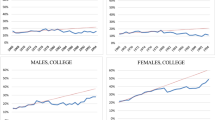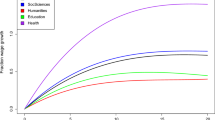Abstract
Among better-educated employed men, the fraction of full-time full-year (FTFY) workers is quite high and stable—around 90 percent—over time in the U.S. Among those with lower education levels, however, this fraction is much lower and considerably more volatile, moving within the range of 62–82 percent for high school dropouts and 75–88 percent for high school graduates. These observations suggest that the composition of unobserved skills may be subject to sharp movements within low-educated employed workers, while the scale of these movements is potentially much smaller within high-educated ones. The standard college-premium framework accounts for the observed shifts between education categories, but it cannot account for unobserved compositional changes within education categories. Our paper uses Heckman’s two-step estimator on repeated Current Population Survey cross sections to calculate a relative supply series that corrects for unobserved compositional shifts due to selection into and out of the FTFY status. We find that the well-documented deceleration in the growth rate of relative supply of college-equivalent workers after mid-1980s becomes even more pronounced once we correct for selectivity. This casts further doubt on the relevance of the plain skill-biased technical change (SBTC) hypothesis. We conclude that what happens to the within-group unobserved skill composition for low-educated groups is critical for fully understanding the trends in the relative supply of college workers in the United States. We provide several interpretations to our selection-corrected estimates.
Similar content being viewed by others
References
Acemoglu, D.: Why do new technologies complement skills? Directed technical change and wage inequality. Q. J. Econ. 113, 1055–1090 (1998)
Acemoglu, D.: Changes in unemployment and wage inequality: an alternative theory and some evidence. Am. Econ. Rev. 89, 1259–1278 (1999)
Acemoglu, D., Autor, D.: Skills, tasks, and technologies: implications for employment and earnings. In: Ashenfelter O., Card, D. (eds.) Handbook of Labor Economics, vol. 4, chap. 12, pp. 1043–1171. Elsevier, New York (2011)
Autor, D.H., Katz, L.F., Kearney, M.S.: Trends in U.S. wage inequality: revising the revisionists. Rev. Econ. Stat. 90, 300–323 (2008)
Autor, D.H., Katz, L.F., Krueger, A.B.: Computing inequality: have computers changed the labor market? Q. J. Econ. 113, 1169–1213 (1998)
Ben-Porath, Y.: The production of human capital and the life cycle of earnings. J. Pol. Econ. 75, 352–365 (1967)
Bound, J., Johnson, G.: Changes in the structure of wages in the 1980’s: an evaluation of alternative explanations. Am. Econ. Rev. 82, 371–392 (1992)
Bowlus, A.J., Robinson, C.: Human capital prices, productivity, and growth. Am. Econ. Rev. 102, 3483–3515 (2012)
Browning, M., Hansen, L.P., Heckman, J.J.: Micro data and general equilibrium models. In: Taylor J.B., Woodford M. (eds.) Handbook of Macroeconomics, Elsevier, vol. 1A, chap. 8, pp. 543–633 (1999)
Card, D., DiNardo, J.E.: Skill-biased technical change and rising wage inequality: some problems and puzzles. J. Labor Econ. 20, 733–783 (2002)
Card, D., Lemieux, T.: Can falling supply explain the rising return to college for younger men? A cohort-based analysis. Q. J. Econ. 116, 705–746 (2001)
Carneiro, P., Lee, S.: Trends in quality adjusted skill premia in the United States, 1960–2000. Am. Econ. Rev. 101, 2309–2349 (2011)
Chamberlain, G.: Asymptotic efficiency in semiparametric models with censoring. J. Econ. 32, 189–218 (1986)
Ciccone, A., Papaioannou, E.: Human capital, the structure of production, and growth. Rev. Econ. Stat. 91, 66–82 (2009)
Davis, S.J., Haltiwanger, J.C.: Wage dispersion between and within U.S. manufacturing plants, 1963–1986. Brookings papers on economic activity: microeconomics, pp. 115–180 (1991)
DiNardo, J.E., Fortin, N.M., Lemieux, T.: Labor market institutions and the distribution of wages, 1973-1992: a semiparametric approach. Econometrica 64, 1001–1044 (1996)
Feenstra, R.C., Hanson, G.H.: The impact of outsourcing and high-technology capital on wages: estimates for the United States, 1979–1990. Q. J. Econ. 114, 907–940 (1999)
Heckman, J.J.: Shadow prices, market wages, and labor supply. Econometrica 42, 679–694 (1974)
Heckman, J.J.: Sample selection bias as a specification error. Econometrica 47, 153–161 (1979)
Heckman, J.J.: Varieties of selection bias. Am. Econ. Rev. 80, 313–318 (1990)
Heckman, J.J., Lochner, L.J., Taber, C.: Explaining rising wage inequality: explorations with a dynamic general equilibrium model of labor earnings with heterogeneous agents. Rev. Econ. Dyn. 1, 1–58 (1998)
Hoynes, H.W., Miller, D.L., Schaller, J.: Who suffers during recessions? J. Econ. Perspect. 26, 27–48 (2012)
Iranzo, S., Peri, G.: Schooling externalities, technology, and productivity: theory and evidence from U.S states. Rev. Econ. Stat. 91, 420–431 (2009)
Katz, L.F., Autor, D.: Changes in the wage structure and earnings inequality. In: Ashenfelter, O., Card, D. (eds.) Handbook of Labor Economics, vol. 1, pp. 1463–1555, Elsevier, New York (1999)
Katz, L.F., Murphy, K.M.: Changes in relative wages, 1963-87: supply and demand factors. Q. J. Econ. 90, 35–78 (1992)
Krueger, A.B.: How computers have changed the wage structure: evidence from microdata, 1984–1989. Q. J. Econ. 108, 33–60 (1993)
Lee, D.S.: Wage inequality during the 1980s: rising dispersion or falling minimum wage? Q. J. Econ. 114, 977–1023 (1999)
Lemieux, T.: Increasing residual wage inequality: composition effects, noisy data, or rising demand for skill? Am. Econ. Rev. 96, 461–498 (2006)
Mincer, J.: Human capital, technology, and the wage structure: what do time series show? NBER Working Paper #3581 (1991)
Moffitt, R.A.: New developments in econometric methods for labor market analysis. In: Ashenfelter, O., Card, D. (eds.) Handbook of Labor Economics, vol. 3A, pp. 1367–1397, Elsevier, New York (1999)
Mulligan, C.B., Rubinstein, Y.: Selection, investment, and women’s relative wages over time. Q. J. Econ. 123, 1061–1110 (2008)
Newey, W.K.: Consistency of two-step sample selection estimators despite misspecification of distribution. Econ. Lett. 63, 129–132 (1999)
Park, J.H.: Estimation of sheepskin effects and returns to schooling using the old and the new cps measures of educational attainment. Industrial Relations Section WP#338, Princeton University (1994)
Violante, G.L.: Skill-biased technical change. In: Blume, L.E., Durlauf, S. N. (eds.) The New Palgrave Dictionary of Economics, 2 edn. MacMillan, New York (2008)
Weiss, Y., Lillard, L.A.: Experience, vintage, and time effects in the growth of earnings: American scientists, 1960–1970. J. Pol. Econ. 86, 427–447 (1978)
Willis, R.J., Rosen, S.: Education and self-selection. J. Pol. Econ. 87, S7—S36 (1979)
Author information
Authors and Affiliations
Corresponding author
Rights and permissions
About this article
Cite this article
Elitas, Z., Ercan, H. & Tumen, S. Reassessing the trends in the relative supply of college-equivalent workers in the U.S.: a selection-correction approach. J Econ Inequal 13, 249–273 (2015). https://doi.org/10.1007/s10888-014-9278-7
Received:
Accepted:
Published:
Issue Date:
DOI: https://doi.org/10.1007/s10888-014-9278-7




